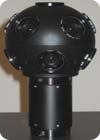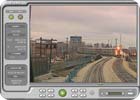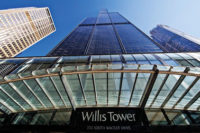That’s why, increasingly, end users are turning to the next generation technology in video security: intelligent video or video analytics.
WHAT’S VIDEO ANALYTICS?
There are many types of video analytics systems available today. Some monitor for different things, but they are all based on the same principle: The video system itself “looks” for a predefined set of circumstances and alerts the operator when they occur.Some of the things video analytics has been used to look for include: anomalous behavior on the part of humans or vehicles; stationary objects that shouldn’t be there; and someone or something crossing a “virtual” border.
The possibilities are endless. But one thing video analytics is NOT is a substitute for human monitoring. Larry Barfield, vice president of government programs for a major manufacturer of analytics systems, was formerly an end user/buyer with the Naval Space and Warfare Systems Center in Charleston, S.C. Through his extensive research and experience with many of these systems, he has come to a very basic conclusion about the place of analytics:
“Machines do some very interesting things very well,” he says. “They compute quickly, they can do repetitive tasks. But humans also do things well, like exercising judgment. My division line on what intelligent video is, is letting machines do what they do best, and letting humans take it from there and do what they do best. You are never going to develop a video system that can tell you whether that’s a bear at your gate or a person dressed in a bear costume.”
Essentially, video analytics automatically computes the differences between one image and the next in a video sequence. In the process, they allow the user to do things with a camera that were not traditionally possible before, and turns the camera itself into an active tool rather than a passive one that must be monitored by someone else.
WHERE IS IT USED?
Video analytics can be used indoors or outdoors and in all environmental situations. In fact, many current applications are border patrol, military, petrochemical and maritime, says integrator Matt Winans, program manager for AMTO, an operation of SAIC.Some applications are non-traditional, he adds. “We are also monitoring interior critical infrastructure. In the maritime environment, it’s the structure of the ship, like the engine room. This technology gives them quick ability for greater situational awareness. By adding a camera with analytics, you now can do things you couldn’t traditionally do with just cameras, such as monitoring for smoke, fire, left behind tools, oil leaks – things that could be really detrimental to the health and integrity of the ship.”
Winans does also use the software for security monitoring of sites. “In one maritime platform we have been working with right now, an offshore platform is actually creating a concentric circle around the platform for incoming small craft. We use a combination of virtual trip wire and an exclusionary zone. As it comes further in, it produces a higher level of alert.”
Analytics is growing in popularity among other segments as well.
“We’re seeing it rapidly branch out into commercial applications,” Winans says. “In the past we have used analytics for all sorts of things, but it was strictly for high-end broad surveillance or government applications. Now there is so much more you can do with it. Instead of the camera just being a tool to watch an area, you can actually turn it into a useful sensor. It is giving you a lot more feedback now than just a sensor.
“As the analytics get more and more intuitive, the price point drops and the processing capabilities go up; these are all helping transition analytics into the commercial world.”
One such commercial application is airline security.
“We use video analytics in our terminal building,” says Mason Short, airport executive director of Rapid City Regional Airport, Rapid City, S.D. “What our system does is detect wrong lane motion through the exit lane. If someone is trying to bypass the security checkpoint, the video system picks up that wrong-way motion. First, it sets off a pre-alarm that someone is approaching the wrong way. Then, if they cross that magic threshold it will set off the full alarm.”
The airport first installed the analytics a year ago, when they saw TSA regulations coming down the pike that would require full-time monitoring of the exit lane. In the year it has been installed, the system has identified three incidents where someone intentionally tried to thwart security, Short says.
“We had an incident last spring where an individual willfully and knowledgeably went down the exit lane to go back down to an aircraft,” he recalls. “He had left something on board the plane, but didn’t want to talk to airline people. So he ran down the exit lane. With the video we were able to record him doing that; we were able to bring Federal charges against him for violating signage, alarms and trying to bypass our security checkpoint.”
In the other two instances, because of the alert the video analytics system gives, security was able to stop the people and turn them around before they exited the checkpoint area.
WHAT ARE THE ADVANTAGES?
Those who do use some form of video analytics all point to one huge benefit: labor savings.“The bottom line is the economy that it gives them,” Winans says. “For the person sitting behind the monitor there is a tendency to just add more and more cameras. Automatically that plays into sensory overload and the inability to continuously monitor for, say, an eight hour period. What analytics gives you is the ability to be autonomous. The camera, instead of providing just a means for monitoring an area, actually monitors the area for you. That is hands down the biggest advantage to intelligent video.”
Another advantage for many is the ability to comply with new regulations without having to add manpower or hassle. “A lot of our customers are looking to comply with a new standard or DHS regulation,” Winans says. “The ability to take something like this and integrate it into their security footprint to comply is huge.”
Short agrees on both fronts. “From our standpoint it is a pretty huge addition, given the TSA staffing levels and the fact that they were looking at trying to decide whether the monitoring of that exit lane would be a TSA or airport duty,” he says. “If we had to provide a staff person, for the airport to do it would cost us a lot of money. Or, on our budget, if TSA had to do it, that takes away from our security here, as we are mainly concerned on the passenger checkpoint about the expedient flow of passengers. So if TSA had to devote one person to watch that exit lane, it would not only cost money and resources for them, but it would slow down our passengers because that would be one less person on the entry end.
“The main thing we are looking at from an operational standpoint is time saving. If we can have a smart, or analytical system that does what a human can do without the ongoing labor cost, for us that was a no brainer. There is an automated solution – something we are continually looking for to keep our budget in line.”
In the year since he has implemented video analytics, Short has been pleased with the results.
“It is absolutely doing what it is supposed to do. We get enough alarms on this machine that we are comfortable that it is doing its job. Even if someone stops on exit and turns their head the wrong way, it picks that up as wrong way motion. We are confident in the tests that we do to measure its success.
“The labor savings is a major business advantage. Also, from our standpoint, the throughput of the checkpoint is huge. We are not in the business of people standing around the terminal building. We want to get them through and onto airplanes.”
With the business case for video analytics so compelling, Winans believes there is nowhere to go but up with this technology. “I think we are just at the cusp of some really great things. It is getting better and better as the required pixels for change from an analytics perspective comes down, you will be able to get more and more types of alerts and alarms as algorithms get further defined. Basically the field is wide open right now.”

Intelligent security video in healthcare
facilities can look in at patients and alert to situations which would put the
person in harm’s way. Photo courtesy of Arteco Vision Systems
SIDEBAR 1: Intelligent Video in Healthcare Environments
There are expanding applications in specific vertical markets that are helping to mainstream intelligent video surveillance (IVS) to make it the standard in video security. An example of this is the healthcare environment, where in addition to providing security to a facility and its inhabitants, it can also alert staff to critical events in real-time, thereby reducing security and safety concerns in a variety of essential areas.Falls, for example, account for a significant portion of injuries in hospitalized patients, long term care residents and home care recipients. Intelligent video is currently being used in healthcare settings to help with the care of patients whose movements or activities must be confined. Security cameras are strategically mounted in the rooms for wide coverage and digital areas of interest are created around the patient beds using the IVS’ analytics software. If a patient gets out of bed or should slip, fall or wander away, the IVS detects this event as abnormal behavior and immediately alerts the personal hand-held communication device (the Nurse Call Station, PDA or Smartphone) of the on-duty staff.
Critical Detection Time (CDT) is the time required for the healthcare staff to effectively respond to a patient in need. For example, if a patient slips and falls in their room and is unable to reach the “nurse call” button, how long will it take for the staff to tend to the patient? Intelligent video’s ability to dramatically reduce CDT makes it the perfect solution to this real-world problem, according to Raymond Rudy of Arteco Vision Systems.

The InnoVision conference, sponsored by i3DVR, brought
together key end users, integrators and makers of security technology.
SIDEBAR 2: InnoVision Taps CSO Needs, Wishes
Sponsored by i3DVR, InnoVision brought together top end users in a single forum to discuss key issues and share industry knowledge on digital video and emerging analytics.At a detailed level, InnoVision explored the opportunity of leveraging technological innovation for business transformation and discussed techniques for managing business and technology change for increased effectiveness. Hal Weaver, corporate senior manager asset protection for Home Depot, gave an insightful presentation. Jean-Francois Bourgoin, loss prevention manager for Tommy Hilfiger Canada, shared his vision of a future with intelligent video.
What follows are reporter’s notes from i3DVR’s InnoVision conference.

Hal Weaver of The Home Depot sees both business and loss
prevention aims through digital, intelligent security video, including
advancing identified metrics and reducing shrink.
- Ability to record and view transactions as they happen at a teller window
- Ability to look up suspects by transaction number (now they have to look up by time transaction happened)
- Transaction time can be different from DVR time, which makes it difficult to relate to person making transaction
- DVR software running as a service (no one would have to log on - improved security)
- Improving key metrics
- Shrink reduction
- Theft deterrence and detection
- Improved customer service
- Operational
efficiencies
What functionality is necessary to address areas of concern? - POS interfacing
- Real-time exception reporting
- Customer count
- Queuing
- Falling object notification
- Customer flow
- Calculates customer conversion rates
- Validates advertising expenditure
- Efficient labor and staffing models
- 95 percent accuracy
- Must have full involvement of IT staff
- DVR is just another PC/Server on the network
- Board’s broadband network critical to success of this approach
- Improve remote compression, but without compromising the resolution
- Improving the detection zone
- PTZ zoom-in / out by right click
- Pop-up control window when in full screen mode (on Remote and on Server)
SIDEBAR 3: Three Elements That Make Video Intelligent
In order for any intelligent video system to be useful, there are three factors that must come together: workable algorithms, image quality and processing power. Without them, an intelligent video system’s usability will be limited, according to Fredrik Nilsson, general manager, Axis Communications.Workable Video Analysis Algorithms
Video analysis algorithms are the basis for intelligent video. In their most fundamental form, the algorithms are “If-Then” statements that analyze video and trigger pre-programmed events. For example, if a person loiters in an area for more than 10 minutes, then a security guard will be paged.
Video analytics companies focus on creating these types of “conditional statements.” The algorithms are getting better, but most have yet to reach 95 percent accuracy – the level they must attain to be truly efficient.
Image Quality
Image quality is critical to the success of intelligent video. After all, the system cannot analyze that which it cannot “see.”
To that end, network cameras have the edge over analog cameras through their use of progressive scan technology and megapixel resolution. These features improve image quality – a must for successful intelligent video applications. Better input data ultimately makes the system more accurate.
Processing Power
The more processing power available to an intelligent video system, the better it will function. Moore’s Law – which states that the number of transistors on an integrated circuit at a minimum component cost doubles every 24 months – works in favor of intelligent video processing.
The processing power available in network video systems today is very good. One server can analyze the video from several cameras, and network cameras themselves are equipped with enough processing power to run intelligent algorithms locally. This prevents a serious drain of power at a central location and means that video can be analyzed faster and with greater accuracy.
Although intelligent video is still in its early stages, it continues to steadily improve. Today it is primarily used in governmental applications, such as seaports and airports, and in retail environments for loss prevention. The analytics will eventually become easier to install and set up, and the results will be more accurate – helping propel intelligent video into mainstream use.

With 11 cameras capturing information from one head, the
information collected allows for more intelligent decision making. Photo
courtesy of Immersive Media
SIDEBAR 4: First Responders Go with Video Intelligence
The Somerset County Prosecutor’s Office (SCPO) in Somerset, N.J. is committed to strengthening law enforcement’s relations with the public, enhancing the quality of life for its citizens, and ensuring the rights of crime victims are enforced while pursuing justice for all. With this mission in mind, the SCPO is continually looking for cost-effective technological advances to increase public safety while simultaneously being less labor-intensive and more efficient.With the SCPO’s resources operating at peak capacity, there was a need to acquire more detailed, accurate information in advance of those critical incidents demanding immediate decisions and minimal response time. A better visual tool was required to pass along data-rich information during briefings which would allow various stakeholders to internalize integral details about facilities and infrastructure, plan maximum surveillance operations, increase execution efficiency and capture high-risk environments along with other law enforcement applications.
Upon experiencing GeoImmersive video, the SCPO felt that the omnidirectional view provided the precise perspectives they desired to enhance their operations far beyond the standard tactics and approach. Immersive Media’s technology was applied across the SCPO to aid with crisis management, training, emergency response planning, live event monitoring and briefing.
The SCPO has found the IMC technological platform useful for crime scene reconstruction and facilitating the justice process. By utilizing such imagery in court cases, Prosecutors can accurately portray key points, distances and re-enactments for jurors. Incident analysis is greatly improved by placing the viewer on the scene. Law enforcement personnel have also benefited from enhanced strategic and emergency plans by mapping the County’s critical infrastructure. Having an in-depth perspective of various potential chokepoints, access areas, evacuation routes, interiors and overall site evaluations combined with vital geo-referenced information enables more detailed tactical plans and operations to be formulated.

Security video on trains, coupled with audio collection, adds
intelligent dimension to train safety. Photos courtesy of Apollo Video Technology
SIDEBAR 5: Digital Video Catches Train Surveillance
Northeast Illinois Regional Commuter Railroad Corporation (Metra) of Chicago has asked for 502 video surveillance systems for its commuter trains from Apollo Video Technology of Bellevue, Wash., and Railhead Vision Systems of Chicago.The $3.2 million contract will provide for the installation of Apollo’s RoadRunner video surveillance systems aboard Metra trains.
The digital color, audio-visual systems will enable Metra to record activities in front and rear of its commuter trains, including the operation of gates and lights at crossings, along the 495-mile, 243-station rail system. Metra, a division of the Regional Transportation Authority, provides over 80 million rides annually throughout six Chicago-area counties.

“Metra’s goals were very clear – they needed the best possible video quality in a highly reliable system,” said Rodell Notbohm of Apollo Video Technology.
“Metra requires video performance that supports exact determination of the train signal colors, so we developed a camera system with three times better color reproduction and twice the resolution of standard mobile video systems,” Notbohm added. “Metra’s system will, without question, have the best video quality of any mobile video system that has preceded it.”

The Clearwater Casino has a winning hand thanks to a virtual
matrix at the heart of its digital security video system.
SIDEBAR 6: Check Out Virtual Matrix Solutions
The Clearwater Casino Resort in Washington state is using an American Dynamics Intellex digital video management solution to transition from its analog system and create a powerful virtual matrix solution. Installed by Reliable Security, the virtual matrix solution allows Clearwater’s surveillance personnel to monitor and manage a highly-diverse security system including multiple security video cameras and digital video management systems from a single surveillance room, creating a virtual wall of monitors.Suquamish Clearwater Casino Resort is a casino and hotel nestled along the shores of the Kitsap Peninsula in Western Washington. The resort sought to improve its security system by transitioning from an analog to a digital system in order to protect the integrity of its high-scale environment. Additionally, it was recognized early on that the surveillance room and its adjoining equipment room were close to being overextended in terms of space and had limited power and electrical infrastructure.
While looking to upgrade its current analog system, Clearwater Casino Resort recognized the increasing popularity of megapixel cameras which produce clearer and sharper images. Since the casino’s current analog system was incompatible with these cameras, the casino required the new system have a migration path for megapixel cameras with digital recording capabilities. Said Bill Jackson, IT director for Clearwater Casino Resort, “With the Intellex system, we can retrieve recorded surveillance footage at a moment’s notice so our surveillance officers can work more effectively. And we now have a clear path to adopt digital cameras in the future via the virtual matrix and its ability to migrate from an analog to digital system.”
